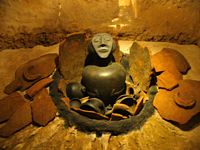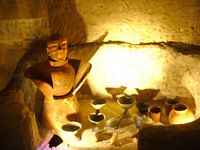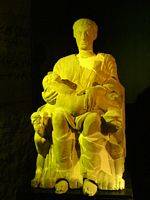On the way from Orvieto to our stay at an agritourismo, we stopped in Chianciano to visit the excellent Etruscan museum there. Roberto was our guide and started with some of the history of the pre-Roman Etruscans. There is controversy about their origin, but Roberto agrees with some scholars who think the Etruscan culture began in the Greek island of Lemnos. The necropolis of the city contained 130 cremated burials. In the women's burials an early form of Etruscan Bucchero pottery was found. Bucchero clay was used by the people of Asia Minor and by the Etruscans. In the male sites daggers and axes of the Cretan and Etruscan models were found. The history of the Etruscans is discussed in length on the website at www.mysteriousetruscans.com/history.html
In this case, Roberto showed us this funerary urn of the 7th century BC. Note the face on the top of the urn.
Another example of the same period with some jars for material to accompany the deceased.
Here is an example from a later period with an image of mother and child.
By the 2nd century BC, the "urns" could have been more in the form of a sarcophagus. This one was used for the ashes of the deceased, since it was not large enough for a body.
The Etruscans had also developed games and other artifacts
Their pottery was similar to Greek pottery, bolstering the theory that they had been influenced by the Greek culture.
Here are the remains of some of their knives and other tools.
The museum also had Roman artifacts, such as jewelry and coins, as well as these statues from a 2nd century AD Roman bath.
We had only begun to scratch the surface of the material in this museum when it was time to leave for Pienza for lunch.








